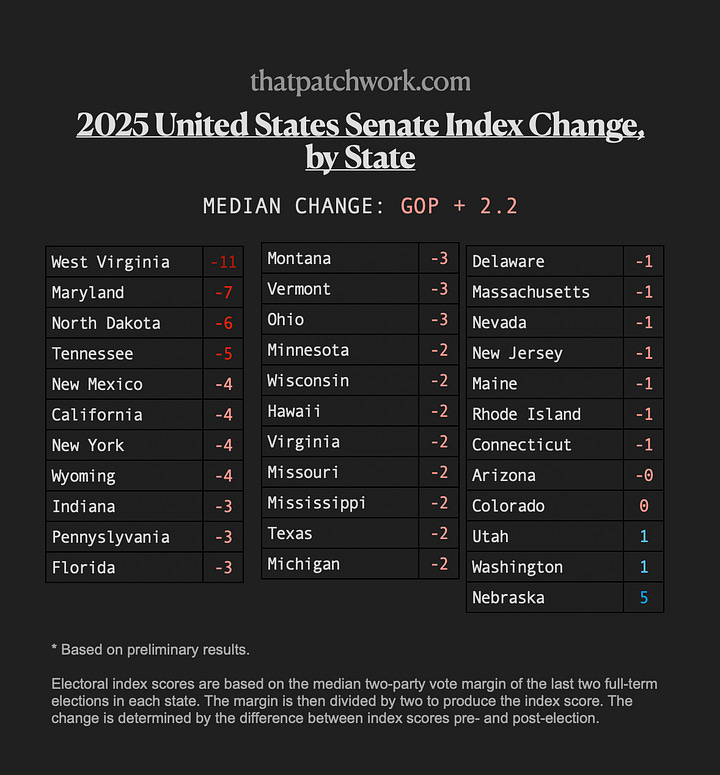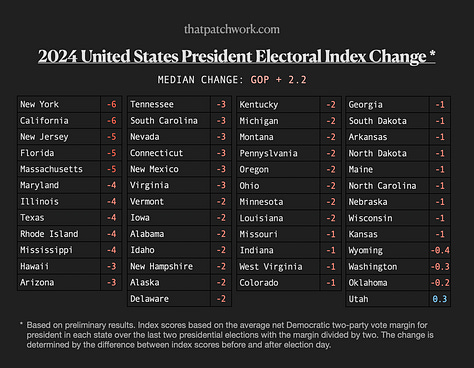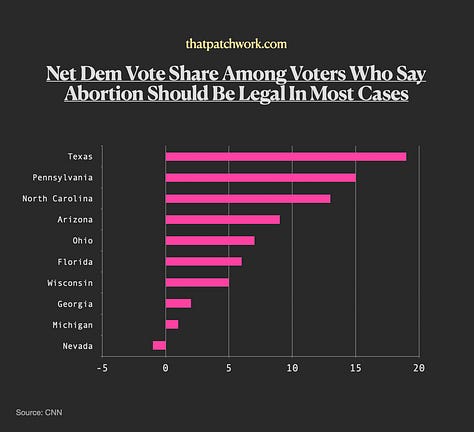The New Multi-Majority
Republicans take their decades-long gains in the states national.
Much has already been written and said—and much more will be written and said—about the causes of the 2024 elections, at least at the federal level. Going into last Tuesday, the race was expected to be highly competitive, but polling could only tell us so much. A decisive victory or an early night wasn’t out of the question. Ultimately, we saw a decisive victory in the presidential and U.S. Senate races, though some close U.S. House races remain undecided as of this writing.
While many political observers had noticed the inklings of a wide coalitional shift from Democrats to Republicans in certain parts of the country in 2020, the prevailing narrative ahead of the election was confusion over how the race could be so close. Many believed that if Kamala Harris had any chance of defeating Trump, it would be with a coalition similar to Biden’s, particularly in the Rust Belt. As a potential first female president and a representative of generational change, Harris was expected to galvanize women, especially post-Dobbs decision, appeal to moderate and center-right suburban voters, and retain or expand the youth and multiracial coalition. None of that happened, and in most instances, the opposite occurred. Core Democratic demographic groups—including women, Generation Z, millennials, Black, Latino, Asian, college-educated, non-college-educated, and urban voters—all shifted toward Trump, sometimes in jaw-dropping numbers. This shift led Trump to a non-binding national popular vote victory, the party’s first presidential popular vote win in 20 years, and more electoral votes than he earned in 2016.
In this post, I’ll briefly recap the swing across the states for the U.S. Senate, Governor, and President and highlight a few key demographic shifts in the most competitive states.
U.S. Senate
Based on preliminary results from 33 full-term Class 1 Senate seats, all but three states shifted toward Republicans. West Virginia, predictably, saw the largest shift following Joe Manchin’s retirement and the election of popular Republican Governor Jim Justice. In Maryland, a former Republican governor made a Senate run more competitive but still fell far short against the Democratic candidate.
In typically competitive Senate states—like Virginia, Texas, Wisconsin, Ohio, Florida, Montana, Pennsylvania, Nevada, and Arizona—all shifted toward Republicans. In Pennsylvania, Ohio, and Montana, Republicans picked up seats, bringing their majority to 52 seats.
For the first time since the 1950s, both of West Virginia and Montana's senators are Republicans. Pennsylvania will once again be represented by one senator from each party. In Wisconsin, Democratic incumbent Tammy Baldwin narrowly won in a state Trump carried this year, unlike her comfortable victory in the “blue wave” of 2018. In Michigan, Democrat Elissa Slotkin will succeed retiring Senator Debbie Stabenow, also by a narrow margin in a state Trump carried. In Nevada and Arizona, slim margins resulted in a Democratic pick-up and a hold, respectively.
Though Senate Democrats did not emerge unscathed, they avoided what could have been a historic defeat: a 56-seat Republican majority unheard of since the 1920s. This election also underscores the waning of the Democrats’ historical grip on the Senate. This is the first time since the early 1950s that the party has lost control of the chamber after only four years.
The Class 1 seats were last up for election in 2018, 2012, and 2006—all favorable environments for Democrats. The median shift in That Patchwork’s U.S. Senate Electoral Index among these seats moved toward the GOP by 2.2 points.
Based on preliminary results, the GOP leads in the U.S. Senate overall by 0.7 points.
Governor
This year, 11 governor elections were held. Democrats carried three seats—in Washington, Delaware, and North Carolina—the latter of which saw significant split-ticket voting. In North Carolina, Josh Stein decisively defeated Lieutenant Governor Mark Robinson, who faced controversy for allegedly posting racist comments online.
While the remaining states turned out as expected, the shifts were not as uniformly Republican as in the Senate and presidential races.
Republicans held onto governorships in Montana, Missouri, Vermont, North Dakota, West Virginia, New Hampshire, Utah, and Indiana. In New Hampshire, former U.S. Senator Kelly Ayotte succeeded popular outgoing Republican Governor John Sununu, though with a slightly smaller margin. New Hampshire, which tends to prefer federal Democrats, continues to lean Republican at the state level. Utah and Indiana saw notable but insufficient shifts toward Democrats to threaten Republican control. Among these 11 seats, the median shift was DEM +2. Based on results from the last two elections in each state, That Patchwork finds that Republicans lead in governorships by 2 points.
Panning out, it’s worth mentioning the Republicans’ lasting power among governorships. They’ve held a majority of governorships and individual legislative chambers since 2011. The most trifectas — where one party controls the governorship, lower legislative chamber, and Senate — that Democrats have held since 1992 was 18 in 1993. For Republicans, the peak was 26 trifectas, reached in 2018. Today, they hold 23. This stands in contrast to the decades Republicans spent in the relative wilderness at the state level, from the New Deal era all the way through the Republican Revolution of 1994.
As the Democrats’ Southern-Midwestern coalition has weakened, Republicans have moved to the center to bring many of these states into their column. The broader appeal the GOP has achieved has provided Senate Republicans with a bench from which to go on the offensive. As I wrote in 2020, Senate Republicans’ overperformance with certain constituencies compared to Republican presidential nominees aligns with the gains Trump has accelerated.


President
Preliminary data shows all but one state, Utah, shifted toward Republicans. In competitive states like Michigan, Pennsylvania, and Wisconsin, the shifts were smaller but decisive, as these states were crucial for Harris’s path to the White House. Early returns from deep-blue states like New Jersey, Connecticut, New York, and California hinted at a challenging night for Harris well before battleground states were called.
In New York and California, Republicans gained a net of 6 points. Biden's 23-point margin in New York dropped to 11 points for Harris. A similar trend was observed in New Jersey. Harris’s underperformance in traditionally Democratic states contributed to her campaign’s fate and enabled Trump to deliver the Republicans their first national popular vote win in 20 years. Overall, the union shifted toward Republicans (for president) by 2.2 points, with the GOP now leading Democrats by 1.3 points.
Some of the largest shifts that buoyed Trump’s victory occurred among traditionally Democratic constituencies, including Gen Z and Latinos.
Exit polls from CNN and other sources show that Gen Z (ages 18-29) shifted up to 24 points toward Trump. In Ohio, he narrowly carried this group 51-49. In Michigan, Texas, and North Carolina, he effectively split the vote and significantly narrowed the 2020 margin in other states.





Latinos also shifted toward Trump, particularly in states with high Latino populations. Trump outperformed his 2020 numbers in Texas, Nevada, and Florida by over 25 points. In Ohio, Michigan, Florida, and Texas, he won the Latino vote by margins between 2 points (Ohio) and 19 points (Michigan). Nationally, Trump secured 45% of the Latino vote, matching George W. Bush’s 2004 record for a Republican.
Though few expected such a strong shift toward Trump among Gen Z, and there were vague expectations regarding Latinos, Harris’s team anticipated strong support from women and pro-choice voters, especially post-Dobbs. However, in all but two states, women shifted toward Trump compared to 2020 by up to five points.
Among voters who believe abortion should be legal “in most cases,” Democrats won by their largest margin in Texas, which has a full abortion ban. In the remaining states, sizable portions of the pro-choice electorate continued to support Trump.
As I’ve previously noted, while abortion is a divisive moral issue, its practical relevance to most women’s daily lives is limited. Although pro-choice voters leaned toward Harris, they did so in numbers reflecting the limited stakes: Trump does not support a national abortion ban, the Supreme Court has upheld access to abortion pills, some states have resisted strict abortion restrictions, and the president has influence on many other pressing issues.
The 2024 elections have underscored a realignment in American politics, with Republicans making historic inroads among demographic groups once considered core to the Democratic base—a trend the GOP has gradually been advancing in various states for decades. This shift was especially stark among young voters and Latinos, who contributed to Trump’s popular vote victory and expanded Republican control in the Senate. Meanwhile, the anticipated backlash to abortion restrictions was far less decisive than expected, revealing the complexity of voter priorities and the limits of single-issue appeals.
However, it is possible to overstate the GOP's victory here. I don’t consider the Republicans’ multi-majority to be especially durable, at least at the federal level. At the state level, Republicans have maintained an edge for some time across governorships and state legislatures (more on the latter once results are certified). I do think this positions the GOP to be a more competitive force federally. The party has made inroads in the Senate, though it continues to hold itself back with mediocre candidates. In the House, the map is closer to even than it has been in many decades. But given the pressures and barriers the party faces from voters and within its own ranks, no one should underestimate the GOP’s ability to get in its own way.




